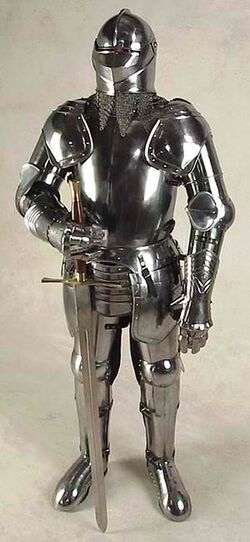Plate armor: Difference between revisions
1d4chan>Tactical Mehren |
1d4chan>Tactical Mehren No edit summary |
||
| Line 3: | Line 3: | ||
A decent plate armored suit could deflect or shatter most blades and arrows that struck it due to its hardiness, requiring those who wielded these weapons to either find chinks in the armor to stab at the wearer (which is a bit hard when he's trying to chop your head off with impunity), or use concussive/heavy piercing weapons like warpicks and warhammers, which could either bypass or penetrate the plating. Arrows had limited effect aswell, although bolts shot from [[crossbow]]s typically had enough power to plow through plate armor with ease. | A decent plate armored suit could deflect or shatter most blades and arrows that struck it due to its hardiness, requiring those who wielded these weapons to either find chinks in the armor to stab at the wearer (which is a bit hard when he's trying to chop your head off with impunity), or use concussive/heavy piercing weapons like warpicks and warhammers, which could either bypass or penetrate the plating. Arrows had limited effect aswell, although bolts shot from [[crossbow]]s typically had enough power to plow through plate armor with ease. | ||
In fantasy, plate armor is typically given to warrior classes to denote their position as the front-line close combat fighters. | In fantasy, plate armor is typically given to warrior classes to denote their position as the front-line close combat fighters. Its commonly also the victim of [[Fantasy Armor]] syndrome where the armor is so bulky beyond belief that you start to wonder how the wearer is able to move, much less fight, when the armor is twice as big and heavy as him. | ||
== Parts of Plate Armor == | == Parts of Plate Armor == | ||
[[File:Plate armor.jpg|250px|thumb|right|A standard suit of plate armor. Use the list to the left to reference the parts]] | |||
*Plate helmet (many variants existed, although they're all designed to protect the head) | *Plate helmet (many variants existed, although they're all designed to protect the head) | ||
**Visor (Covered the face. Was usually hinged with the helmet, although some people did not bother with visors) | **Visor (Covered the face. Was usually hinged with the helmet, although some people did not bother with visors) | ||
Revision as of 07:22, 24 October 2015
Plate Armor is, simply put, armor made of solid plates of metal, essentially a slab of metal made to be worn by people. The armor is typically heavy, cumbersome and physically taxing, which impairs the mobility of the user compared to those who wear lighter suits, like chainmail (People typically got around this by riding war horses to give them mobility....if they could afford one anyway). Although, the tradeoff is that the user is largely impervious to most weapons developed during its prime.
A decent plate armored suit could deflect or shatter most blades and arrows that struck it due to its hardiness, requiring those who wielded these weapons to either find chinks in the armor to stab at the wearer (which is a bit hard when he's trying to chop your head off with impunity), or use concussive/heavy piercing weapons like warpicks and warhammers, which could either bypass or penetrate the plating. Arrows had limited effect aswell, although bolts shot from crossbows typically had enough power to plow through plate armor with ease.
In fantasy, plate armor is typically given to warrior classes to denote their position as the front-line close combat fighters. Its commonly also the victim of Fantasy Armor syndrome where the armor is so bulky beyond belief that you start to wonder how the wearer is able to move, much less fight, when the armor is twice as big and heavy as him.
Parts of Plate Armor

- Plate helmet (many variants existed, although they're all designed to protect the head)
- Visor (Covered the face. Was usually hinged with the helmet, although some people did not bother with visors)
- Gorget (covers the neck)
- Spaulders (covers the shoulders)
- Pauldrons (an evolution of the spaulders. Pauldrons are larger than spaulders, not only covering the shoulder, but most of the upper arm as well. They're also reliable as blunt implements to shoulder charge somebody with.)
- Rerebraces (covers the upper arms)
- Couter (covers the elbows)
- Vambraces (covers the forearms)
- Gauntlets (covers the hands)
- Curiass (plate which covers the torso)
- Breastplate (single plate which covers the front of the torso)
- Backplate (covers the back of the torso)
- Tassets (covers the upper legs. They're the plate skirt that covered the cuisse)
- Cuisses (covers the thighs)
- Poleyn (covers the knees)
- Greaves (covers the lower legs)
- Sabatons (boots for walking and covers the feet)
Plate armor by region
- Ancient Greece
- Medieval Europe
- Japan